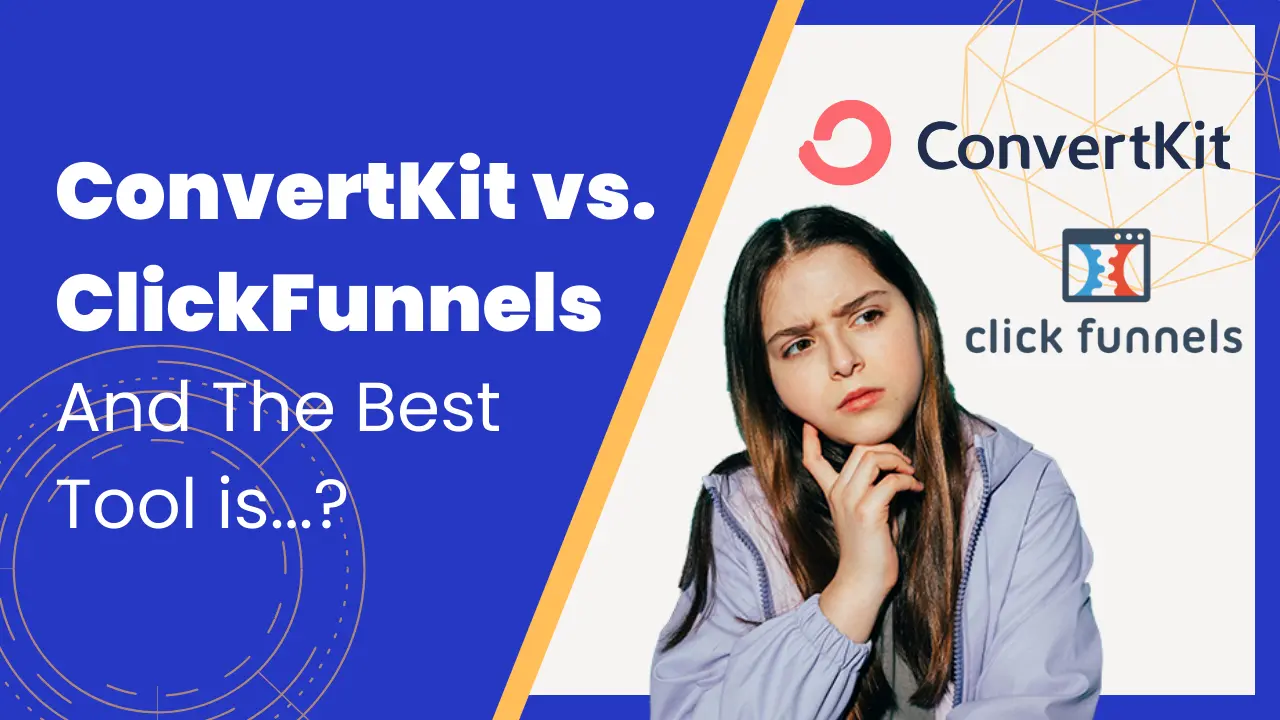ConvertKit vs ClickFunnels: Which Tool Is The Perfect Fit? (2024)

As an online marketer, you are always on the lookout for the right tools that can streamline your work and boost your conversions. With a plethora of options available, choosing the right one can be a daunting task. In this guide, we are going to provide a comprehensive comparison between two big players in the digital marketing space, ConvertKit vs ClickFunnels. So, let’s dive right in!
Understanding The Basic Concepts: Sales Funnel and Email Marketing
Before we dive into the comparison, it’s crucial to understand the fundamental concepts behind these tools. Both ConvertKit and ClickFunnels are designed to help you build and manage your sales funnels and email marketing campaigns.
A sales funnel is a visualization of the customer journey from the first interaction with your brand to the final purchase. It’s called a funnel because it starts broad, with a large number of potential customers, and narrows down as prospects move through different stages of the buying process. At each stage, some potential customers drop out, leaving only the most engaged ones to become buyers.
Email marketing, on the other hand, is a method of promoting products or services through email. It is a direct form of marketing, similar to marketing through snail mail, but email marketing is much more efficient for your wallet and for the environment since it’s paperless!
Now, let’s look at the two tools at hand.
An Overview of ConvertKit and ClickFunnels
What is ConvertKit?
ConvertKit is an email marketing software primarily geared towards online creators such as bloggers, vloggers, podcasters, and other professionals who build and monetize their audience online. ConvertKit allows its users to create attractive forms and landing pages to attract and engage their audience, send out high-converting emails, and track the performance of their campaigns. It’s a tool designed to help you grow your audience and connect with your subscribers more effectively.
What is ClickFunnels?
ClickFunnels, on the other hand, is an all-in-one tool that allows businesses to build highly converting sales funnels. It provides tools that can help you design landing pages, set up product launches, host webinars, and create membership sites. It aims to simplify the marketing and sales funnel process for businesses.
Features Showdown: ConvertKit vs ClickFunnels
ConvertKit Core Features
Tag-Based Email Segmentation
ConvertKit allows you to manage your email subscribers through tag-based segmentation. This means you can tag your subscribers based on their behaviors, interests, or other criteria, and send targeted emails to each group. This level of personalization can significantly improve your email open rates and conversions.
Automation and Workflows
ConvertKit provides a visual automation builder that allows you to create automated email sequences easily. This means once you set up your automation, ConvertKit will automatically send emails to your subscribers at the right time, saving you time and effort.
A/B Split Testing
ConvertKit offers A/B split testing, but it’s limited to email subject lines only. While this feature can help you identify which subject lines get the most opens, it might not be enough if you want to test other elements of your emails like the content or design.
Email Form Builder and Landing Pages
ConvertKit offers a simple yet functional form builder and landing page creator. While it might not be as robust as other tools, it can be enough if you’re just starting out and need to build straightforward forms and landing pages.
ClickFunnels Core Features
Comprehensive Solution
ClickFunnels offers a comprehensive solution for your marketing needs. It allows you to build landing pages, create sales funnels, set up product launches, host webinars, and even manage your affiliate program. It’s designed to be a one-stop-shop for your online marketing needs.
Advanced A/B Testing
In contrast to ConvertKit, ClickFunnels provides advanced A/B testing options. You can split test your entire sales funnel, including your landing pages, upsells, downsells, and emails. This allows you to optimize every step of your customer journey for maximum conversions.
Funnel Sharing
ClickFunnels offers a unique feature called funnel sharing. This allows you to share your funnels with others, which can be useful if you have team members or clients who need access to your funnels.
Comparing Pricing: ConvertKit vs ClickFunnels
Let’s now look at how much these tools will cost you.
ConvertKit offers a free plan with limited features suitable for beginners. The paid plans start at $29 per month for up to 1,000 subscribers, with additional costs as your subscriber count increases.
ClickFunnels, on the other hand, starts at $97 per month for the basic plan. While it is pricier than ConvertKit, it includes a broader range of features and tools that can help you run your entire business.
Final Verdict: ConvertKit vs ClickFunnels?
When it comes to choosing between ConvertKit and ClickFunnels, the decision ultimately depends on your specific needs and budget.
If you’re an online creator looking to grow your audience and enhance your email marketing efforts, ConvertKit might be the right choice for you. It offers all the essential features for email marketing and audience growth at a more affordable price.
However, if you’re a business owner looking for an all-in-one solution that can handle all aspects of your sales funnels, ClickFunnels may be worth the investment. Despite being pricier, it offers more advanced features and tools that can help scale your business.
Remember, the best tool is the one that fits your needs and helps you achieve your business goals. So, consider your specific requirements, take advantage of the free trials offered by both tools, and make an informed decision.
Additional Information
It’s also worth mentioning that both tools offer great customer support and have a wealth of educational resources to help you get the most out of their features. And if you’re already using one of these tools, you might be interested in exploring integrations with other marketing tools to further optimize your campaigns. Each platform has its own strengths and weaknesses, so understanding these differences can help you make the best choice for your business.
Lastly, remember that no tool can guarantee success. It’s how you use these tools that will ultimately determine the results you’ll get. So, invest time in learning how to use your chosen tool effectively, test different strategies, and continuously optimize your campaigns based on your results.
In the end, whether you choose ConvertKit vs ClickFunnels, the most important thing is to stay focused on your goals, be consistent in your efforts, and keep refining your strategies based on your results and what you learn along the way.






